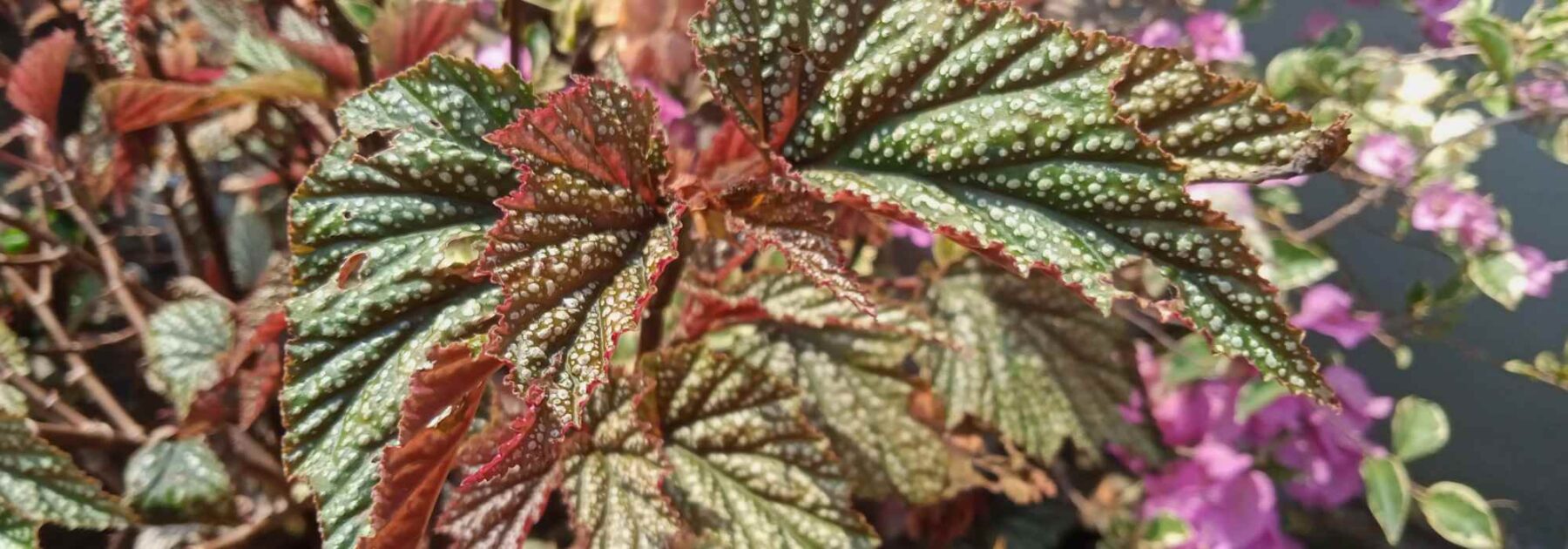
Indoor Begonias: Cultivation and Care
Contents
Indoor begonias in a nutshell
- Indoor begonias stand out either for their variety of decorative foliage or for their delicate flowering.
- They thrive in indirect light, a light substrate, and moderate watering.
- Their propagation is simple, through leaf or stem cuttings, depending on the variety.
- These plants require good ambient humidity and vigilance against pests and diseases.
- Versatile and elegant, begonias add a touch of exoticism to any interior.
The word from our expert
Indoor begonias captivate with their incredible diversity and their ability to blend into any style of décor. Whether grown for their spectacular foliage or delicate blooms, these versatile plants bring a touch of exotic elegance to our homes. With nearly 2000 species from the Begoniaceae family worldwide, they come in unique shapes, colours, and textures. Take, for example, the Begonia rex ‘Escargot’, famous for its spiral leaves, or the Begonia elatior, cherished for its abundant flowers.
Easy to grow, indoor begonias thrive in soft, indirect light, with a light and well-draining substrate. Their care requires moderate watering, regular fertilisation during the growing season, and a slightly humid atmosphere to avoid stress. Some, like the Begonia maculata, thrive in terrariums, while others, such as the Begonia semperflorens, provide continuous blooms in bright interiors.
These plants propagate easily, offering the chance to share their beauty with other plant enthusiasts. Foliage begonias, like the Begonia rex, can be propagated through leaf or stem cuttings, while flowering begonias, such as the Begonia amphioxus, are ideally propagated through stem cuttings or seeds.
Indoor begonias, however, are susceptible to pests like aphids and diseases such as powdery mildew. Careful observation, controlled watering, and a healthy environment nevertheless help keep these plants in top condition. Versatile and aesthetic, begonias have become a must-have for plant décor: why not start a collection?
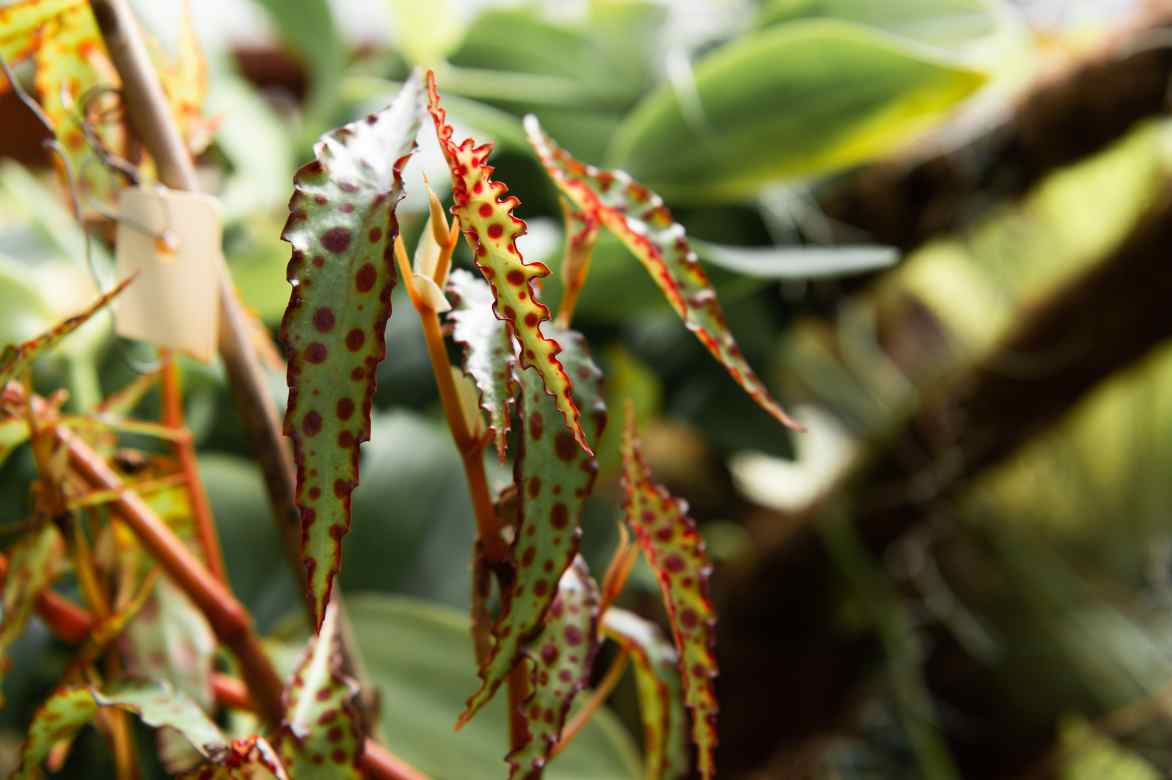
Begonia amphioxus
Botany and description
Botanical data
- Latin name Begonia sp.
- Family Begoniacées
- Common name Bégonia, Bégonia rex
- Flowering juin à septembre
- Height 30 cm
- Exposure lumineux sans soleil direct
- Soil type riche, léger et bien drainé
- Hardiness 12°C
The indoor begonia belongs to the botanical family Begoniaceae, a vast family comprising over 1,800 species. The genus Begonia derives its name from the French governor Michel Bégon, a passionate botanist in the 17th century, whom the botanist Charles Plumier wished to honour. In French, begonias are often simply called begonias, but some types bear more evocative names such as the bamboo begonia or the rex begonia, famous for its spectacular foliage.
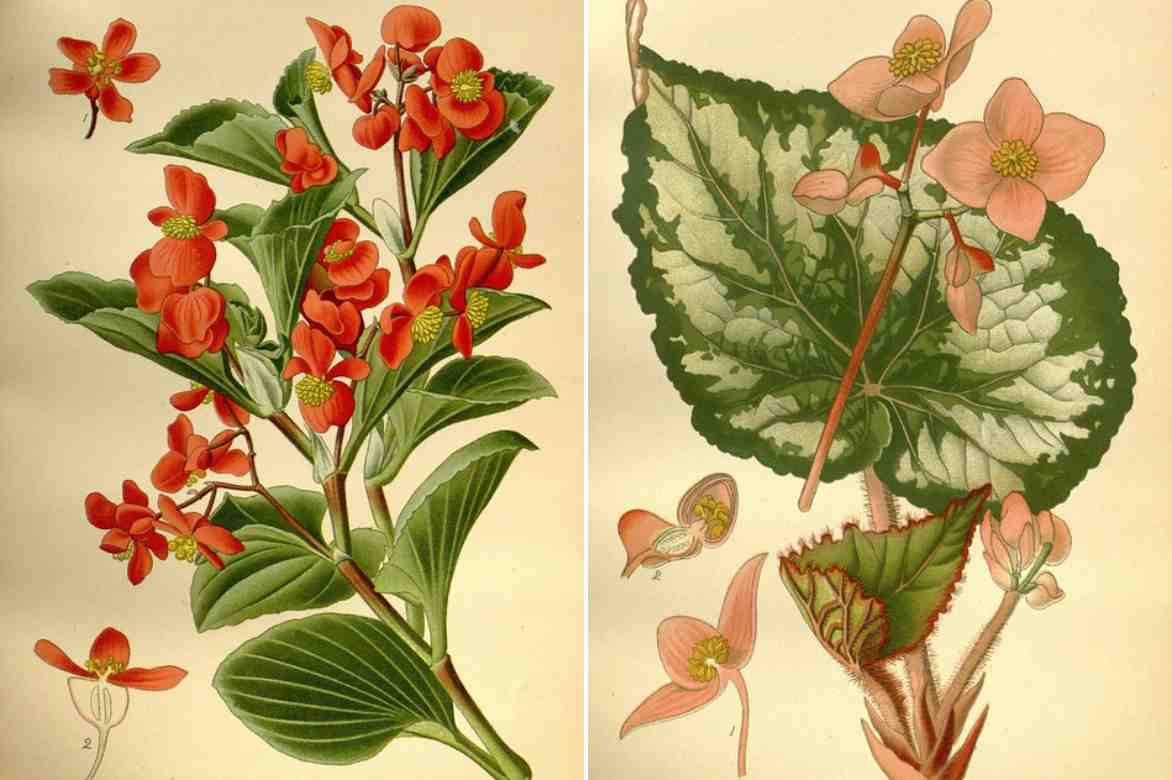
Botanical plates circa 1896: Begonia semperflorens and Begonia rex
In their natural habitat, begonias thrive mainly in tropical and subtropical regions, nestled in humid undergrowth where filtered light and constant humidity provide ideal conditions. This connection with shady and humid environments partly explains why they flourish so well indoors. Their great popularity as houseplants is due to several assets: their incredible diversity of shapes and colours, ranging from decorative foliage to vibrant blooms, and their ability to adapt to moderate light conditions, perfect for living spaces. Easy to integrate into interior décor, begonias add a touch of exoticism and refinement, while requiring relatively little maintenance.
Two distinct families: foliage begonias and flowering begonias
Among indoor begonias, two main families stand out: begonias cultivated for their spectacular foliage and those prized for their delicate flowers.
Foliage begonias, often associated with the famous Begonia rex, are distinguished by their large, colourful leaves, often with surprising patterns. Among the most sought-after varieties are the Begonia Rex ‘Escargot’, recognisable by its spiral leaves reminiscent of a snail’s shell, or the Begonia Rex ‘Chayo’, which shines with its vivid and bold hues. Other examples include the Begonia Rex ‘Red Heart’, with its deep and captivating red, the Begonia Rex ‘Dark Mambo’, with its almost mystical appearance in dark tones, and the Begonia Rex ‘Dew Drop’, which brightens interiors with its silvery highlights. The Begonia maculata, with its elongated leaves adorned with white spots, is also an icon among decorative begonias.

Begonia rex ‘Escargot’ and Begonia maculata
On the other hand, flowering begonias captivate with their abundant and elegant blooms. Although less extravagant in their foliage, they more than compensate with their delicate and colourful flowers. The Begonia amphioxus offers fine, spotted foliage that harmoniously accompanies its small flowers. The Begonia ‘Pink Pop’, meanwhile, enchants with its pink blooms that add a touch of softness. The Begonia eliator, with its rose-like flowers, is another highly popular species. Finally, the Begonia semperflorens, also known as the bedding begonia, brings delicate and persistent flowers that brighten interiors with charming simplicity.
Botanical characteristics of the Begonia genus
The Begonia genus encompasses a great diversity of plants, with varied botanical characteristics, but sharing common traits that make them easily recognisable and cherished.
Plant habit
Begonias display a wide variety of habits, ranging from compact and creeping species to more imposing and upright plants. The Begonia maculata, with its slender stems and pendulous, wing-shaped leaves, can reach up to 60 cm in height, while the Begonia rex, more compact, forms a dense and low clump.

Begonias of all shapes and habits create a beautiful “jungle” ensemble
Root system
Begonias exhibit three main types of root systems: fibrous, tuberous, and rhizomatous. Rhizomatous begonias, such as the Begonia rex ‘Escargot’, develop an underground system of thick rhizomes that allow them to store reserves and produce new shoots. Tuberous begonias, like the Begonia tuberhybrida, possess tubers, making them particularly suited to seasonal cycles of dormancy and growth. Finally, fibrous-rooted begonias, such as the Begonia semperflorens, have fine and dense roots that adapt easily to various substrates.
Foliage
Foliage is undoubtedly one of the most emblematic traits of the genus. Begonia leaves are often asymmetrical, a unique characteristic in the plant kingdom. They display a variety of shapes, colours, and textures. For example, the Begonia maculata offers elongated leaves adorned with white spots, while the Begonia rex ‘Red Kiss’ exhibits broad, velvety leaves marked with intense red patterns. The leaves can be smooth, puckered, or edged with serrations.
Flowering
Begonia flowers, often unisexual (plants bear distinct male and female flowers), vary in size and colour. Flowering begonias, such as the Begonia eliator, produce spectacular blooms in shades ranging from white to bright pink, red, and orange. Each flower is composed of two to four coloured tepals, which can be single or double.
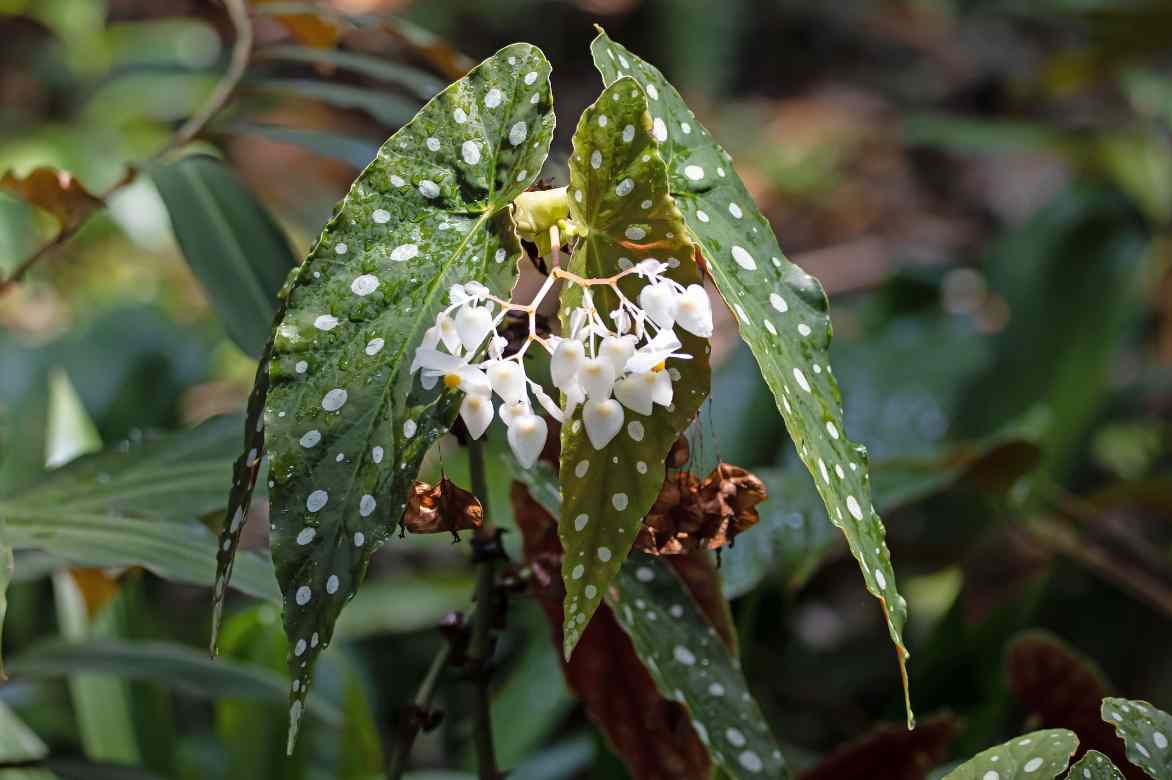
Bloom of the Begonia maculata
Seeds
Begonias produce extremely fine and light seeds, almost like dust. These tiny seeds, contained in small capsules, require specific conditions to germinate, including indirect light and constant humidity.
Did you know? Although primarily known as indoor or semi-tropical plants, some species and varieties of begonias are sufficiently hardy to be grown outdoors in the garden. This is the case for the Begonia grandis ssp. evansiana, which can tolerate temperatures as low as -10 °C when well protected.
Read also
Overwintering Tuberous BegoniasContainer planting
When to Plant a Begonia in a Pot?
Spring is the ideal time to plant a begonia in a pot, as temperatures begin to warm up and the risk of frost has passed. This coincides with the start of the begonia’s active growing season.
Which Substrate to Choose?
Begonias thrive in a light, well-draining, and organic-rich substrate. A specialised indoor plant compost or a homemade mix of universal compost, peat, and perlite is perfect to prevent waterlogging. Adding compost can also enrich the mixture.
Where to Place the Pot?
Place the pot in a bright spot, but avoid direct sunlight, which can scorch the delicate foliage. Indirect light near an east- or north-facing window is ideal. If you’re growing a flowering begonia, such as a Begonia eliator, ensure it receives enough light to encourage blooming.
Which Pot to Choose?
A terracotta pot is ideal, as it allows the roots to breathe and prevents excess moisture, which is common with begonias. The pot size should match the plant: choose one slightly larger than the root ball (about 2 to 3 cm wider in diameter). A pot that’s too large can retain too much water, risking root rot. Ensure it has drainage holes.
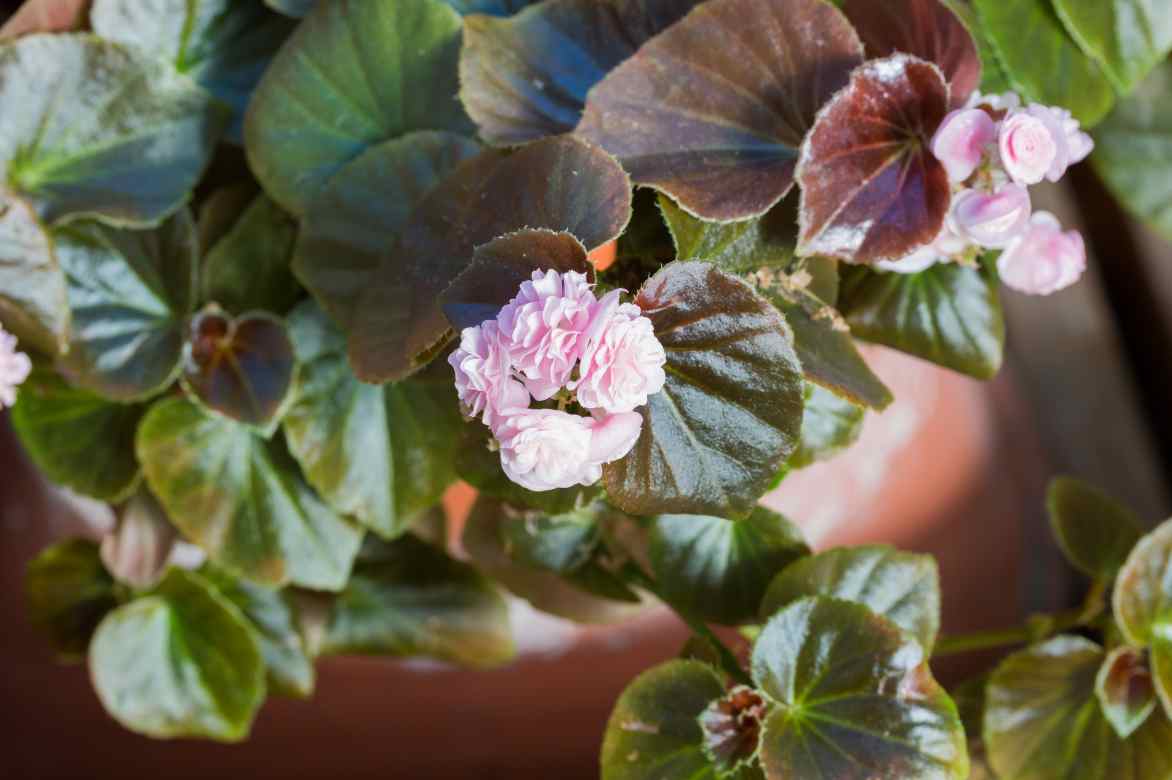
Begonia tuberhybrida
How to Plant the Begonia?
- Place a layer of clay pebbles or gravel at the bottom of the pot to improve drainage.
- Fill the pot halfway with the prepared substrate.
- Position the begonia’s root ball, ensuring the crown (base of the stems) is not buried.
- Fill in around the root ball with substrate, lightly firm it down, then water to moisten the mixture.
Potential Repotting
Begonias dislike being root-bound, but they can tolerate staying in their original pot as long as the roots aren’t overcrowded or the substrate isn’t too compacted. Repotting every 2 to 3 years, ideally in spring, is sufficient to refresh the substrate and give the plant more space. When repotting, choose a slightly larger pot and replace as much substrate as possible without damaging the roots.
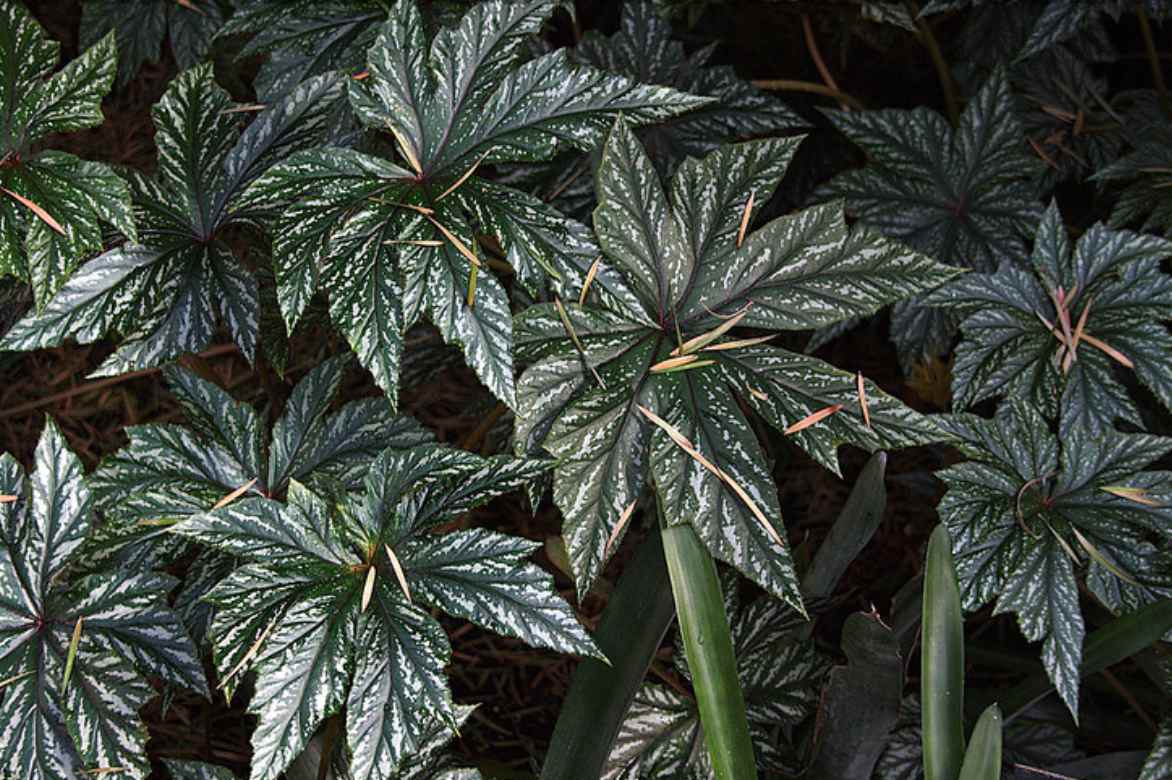
Begonia hybrida ‘Gryphon’
Cultivation and care
Watering
Watering should be moderate but regular. Begonias dislike excess water, which can lead to root rot. Allow the surface of the substrate to dry slightly between waterings, then water until it drains through the drainage holes. Use preferably room temperature, non-calcareous water. In winter, reduce watering, especially for varieties that enter partial dormancy, such as some tuberous begonias.
Fertilisation
During the growing season (spring-summer), apply a liquid fertiliser for flowering or foliage plants every two to three weeks. Foliage begonias, such as Begonia rex, benefit from a nitrogen-rich fertiliser to support the growth of their decorative leaves. Flowering begonias, such as Begonia eliator, will appreciate a balanced or slightly potassium-enriched fertiliser to encourage blooming. In autumn and winter, stop or reduce fertilisation.
Pruning
Pruning is rarely essential for begonias, but it can be useful to maintain a compact and harmonious plant. Remove yellowed, dry, or damaged leaves to prevent the risk of disease. For flowering begonias, regularly pinch off faded flowers to stimulate the production of new blooms. For some varieties like Begonia maculata, pruning overly long stems can also encourage denser branching.
Precautions to take
- Light: Begonias appreciate indirect, soft light. Too much direct light can scorch their leaves, while insufficient light can hinder their growth and limit flowering.
- Humidity: They prefer a slightly humid atmosphere, but avoid misting the leaves directly, as this can cause fungal diseases. If the air is dry, place a tray of water with pebbles under the pot or use a humidifier.
- Temperature: Keep them in a temperate environment between 18 and 24 °C. Begonias dislike cold drafts and sudden temperature changes.
Tip for a long life: Regularly rotate the pot to prevent the plant from growing unevenly towards the light. Also, clean dusty leaves with a damp cloth to maximise their ability to absorb light.
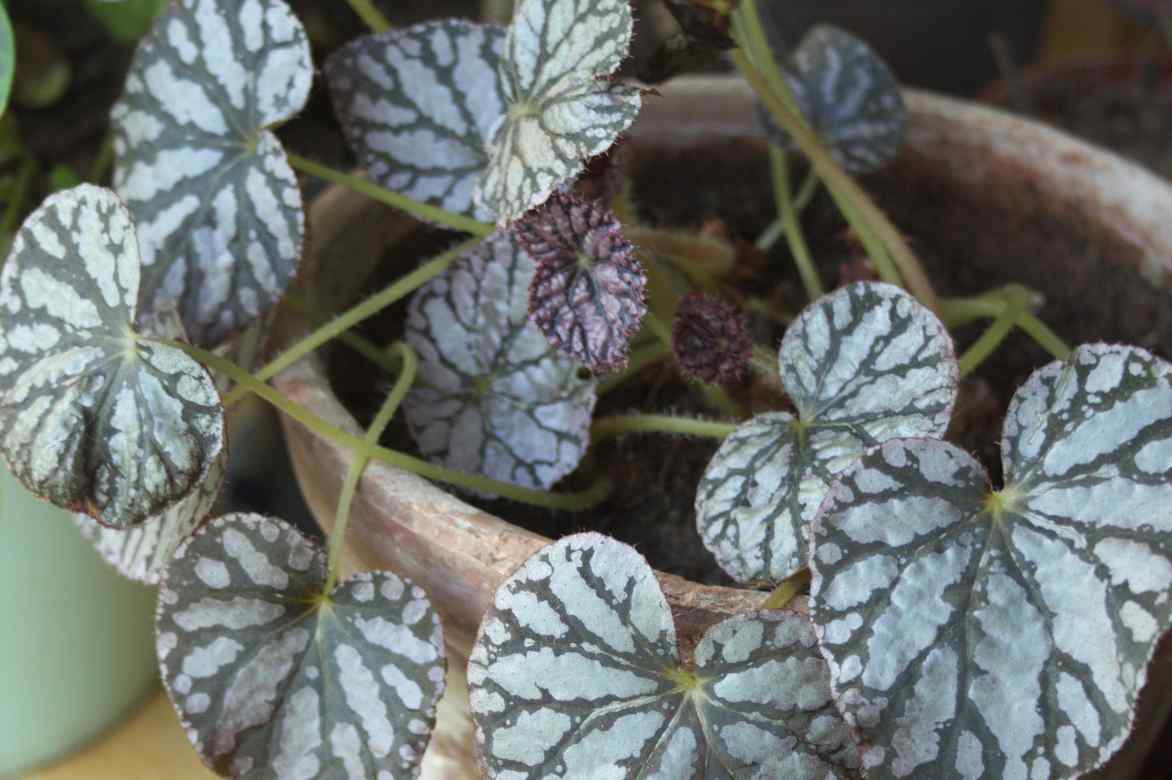
Begonia rex ‘Silver Dollar’
Potential Pests and Diseases
Common Pests
- Aphids
Aphids are small green, black, or yellow insects that settle on new shoots or under leaves. They feed on sap and weaken the plant, causing deformed or yellowed leaves. To learn more, read our advice sheet Aphids: Identification and Treatments.- Solution: treat with a solution of diluted black soap in water.
- Mealybugs
Mealybugs are recognisable by their white, cottony clusters on stems or at the base of leaves. They also feed on sap and weaken the plant. To learn more about mealybugs, read our advice sheet Mealybugs: Identification and Natural Treatments.- Solution: remove them manually using a cotton swab soaked in 70° alcohol.
- Spider Mites
These tiny mites thrive in dry and warm environments. They cause yellowed leaves and sometimes a fine web under the foliage. To learn more, read Spider Mites: Identification and Treatment.- Solution: increase humidity around the plant and treat with a homemade solution of black soap.
- Thrips
These small, elongated insects feed on leaves, leaving silvery spots and discolouration. To learn more, read Thrips: Identification and Natural Treatments.- Solution: use blue sticky traps.
Common Diseases
- Downy Mildew
Downy mildew is a fungal disease that manifests as yellow or brown spots on leaves, often accompanied by a greyish down on the underside. It develops in humid and poorly ventilated conditions.- Solution: avoid overwatering and improve air circulation around the plant. Treat with a copper-based fungicide.
- Powdery Mildew
This disease, also caused by a fungus, forms a white powder on leaves. It usually appears during strong temperature or humidity fluctuations. To learn more, read Powdery Mildew: Prevention and Treatment.- Solution: remove affected parts and apply a natural fungicide treatment, such as a diluted baking soda solution.
- Root Rot
This occurs due to overwatering or poor drainage. Roots turn black and soft, and the plant begins to wilt.- Solution: if roots are affected, repot the plant in fresh soil after removing rotten parts. Be careful not to overwater.
- Bacterial Blight
Translucent, water-soaked spots may appear on leaves, caused by a bacterial infection favoured by stagnant humidity.- Solution: remove affected leaves and avoid watering the foliage. Ensure good ventilation.
General Prevention
- Control Watering: water moderately and only when the soil surface is dry.
- Improve Airflow: place begonias in a well-ventilated area, but away from cold drafts.
- Regular Monitoring: inspect leaves, stems, and the underside of leaves to detect early signs of pests or diseases.
- Maintain Good Hygiene: remove dead leaves and regularly clean the pot and its surroundings to prevent pest proliferation.
Propagation of Indoor Begonias
Foliage begonias, such as Begonia rex or Begonia maculata, are typically propagated through cuttings or division, easy and effective methods to reproduce these plants with their unique foliage.
When to propagate?
The best time to propagate foliage begonias is in spring or early summer, when the plant enters its peak growth period and has optimal energy to form new roots.
How to propagate?
- Leaf cuttings:
- Take a healthy, well-developed leaf with its petiole (the stem connecting the leaf to the plant).
- Cut the leaf into sections if it is large, ensuring each piece contains a main vein.
- Plant the leaf sections or petiole in a light mix of compost and sand, vein side down. Keep the substrate slightly moist and place under a cloche or transparent plastic bag to maintain constant humidity.
- Roots and new plantlets will appear within a few weeks.
- Stem cuttings:
- Cut a healthy stem about 8-10 cm long with 2 to 3 leaves.
- Remove the lower leaves, keeping only the top ones.
- Plant the stem in a light substrate, water moderately, and place under a cloche or in a warm, bright spot, but out of direct sunlight.
- Rhizome division (for rhizomatous begonias, such as Begonia rex):
- Carefully dig up the mother plant and divide the rhizome into several sections, ensuring each piece has at least one bud or shoot.
- Plant the sections in individual pots with fresh compost.
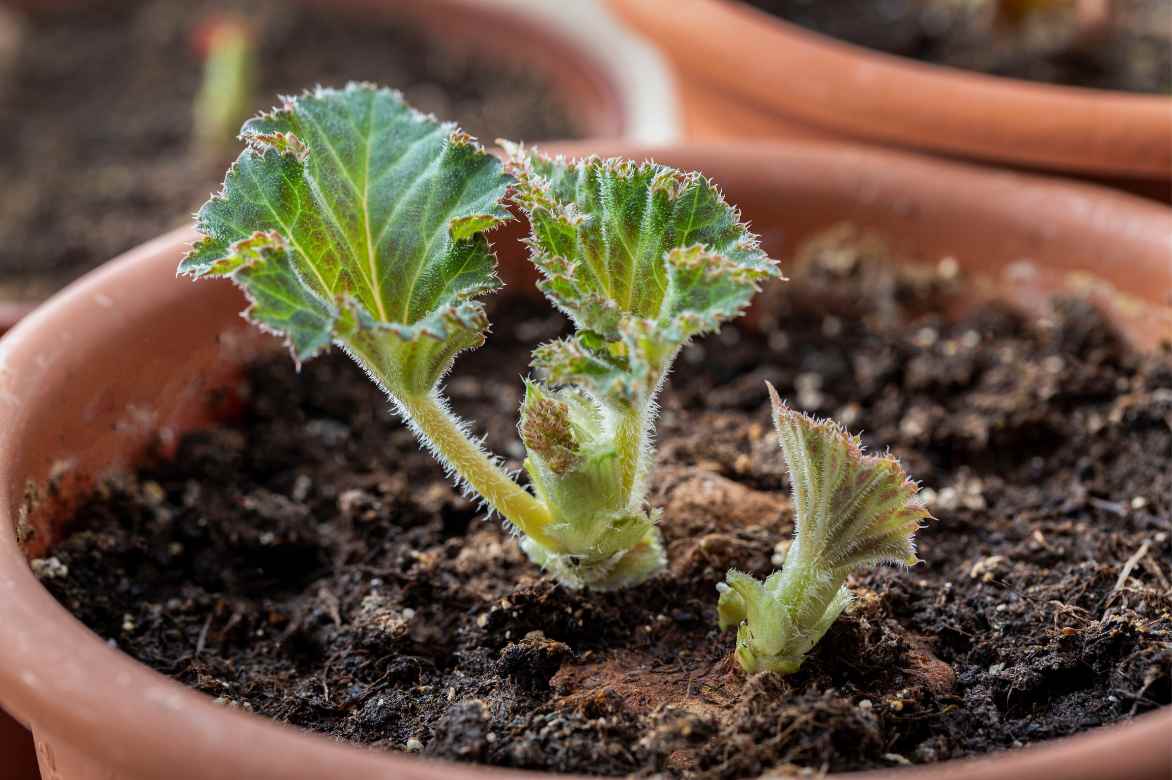
tuberous begonia
Propagation of flowering indoor begonias
Flowering begonias, such as Begonia eliator or Begonia semperflorens, are mainly propagated through stem cuttings or seeds, depending on the variety.
When to propagate?
Propagation of flowering begonias is ideally done in spring or summer, when they are in their active growth phase.
How to propagate?
- Stem cuttings:
- Take a healthy stem 8 to 12 cm long, just below a node, removing the lower leaves to keep only 2 or 3 at the top.
- Plant the stem in a light, moist substrate (a mix of compost and sand or perlite).
- Place the pot in soft light and under a cloche or plastic bag to maintain high humidity.
- Roots usually form within 3 to 4 weeks.
- Seeds (for Begonia semperflorens):
- Sow the seeds on the surface of a very fine, well-draining mix, as begonia seeds are tiny and should not be covered with substrate.
- Maintain a temperature between 20 and 22 °C, with constant humidity (place under a transparent plastic lid or in a mini greenhouse).
- Seeds germinate in 10 to 20 days. Once the seedlings are large enough, transplant them into individual pots.
Tips for successful propagation
- Always use clean and disinfected tools (knives, scissors) to avoid spreading diseases.
- Provide your cuttings or seedlings with soft light and constant humidity, but avoid overwatering, which can cause rot.
- Be patient: some varieties, especially those propagated by seeds or leaf cuttings, take time to develop new roots or plantlets.
How to showcase your begonias?
Decorative Foliage Begonias: A Graphic and Sophisticated Touch
With their vibrant colours and unique patterns, foliage begonias, such as Begonia rex or Begonia maculata, perfectly complement modern, bohemian, or contemporary interiors.
- In which interior?
- Modern or minimalist style: These begonias add contrast and texture, especially in clean spaces dominated by neutral tones (white, grey, beige). The Begonia maculata, with its white spots on a green background, is particularly effective for adding character.
- Vintage or retro style: Pair them with antique furniture or brass and copper accessories for a warm atmosphere. The Begonia Rex ‘Escargot’, with its hypnotic spirals, blends well with this type of decor.
- Urban jungle style: In a room filled with plants, a Begonia rex ‘Red Heart’ or ‘Dark Mambo’ becomes a centrepiece thanks to its deep hues and lush appearance.
- In which type of pot?
- Coloured or textured ceramic pots: Ideal for highlighting the intense colours and leaf patterns. For example, a midnight blue or emerald green ceramic pot beautifully complements a Begonia rex ‘Red Kiss’.
- Natural terracotta pots: Perfect for a bohemian or jungle interior, as the material enhances the complex nuances of the foliage.
- Open terrarium: Rhizomatous or compact begonias like the Begonia Rex ‘Dew Drop’ are ideal for compositions with mosses and other small plants, creating a mini tropical forest.
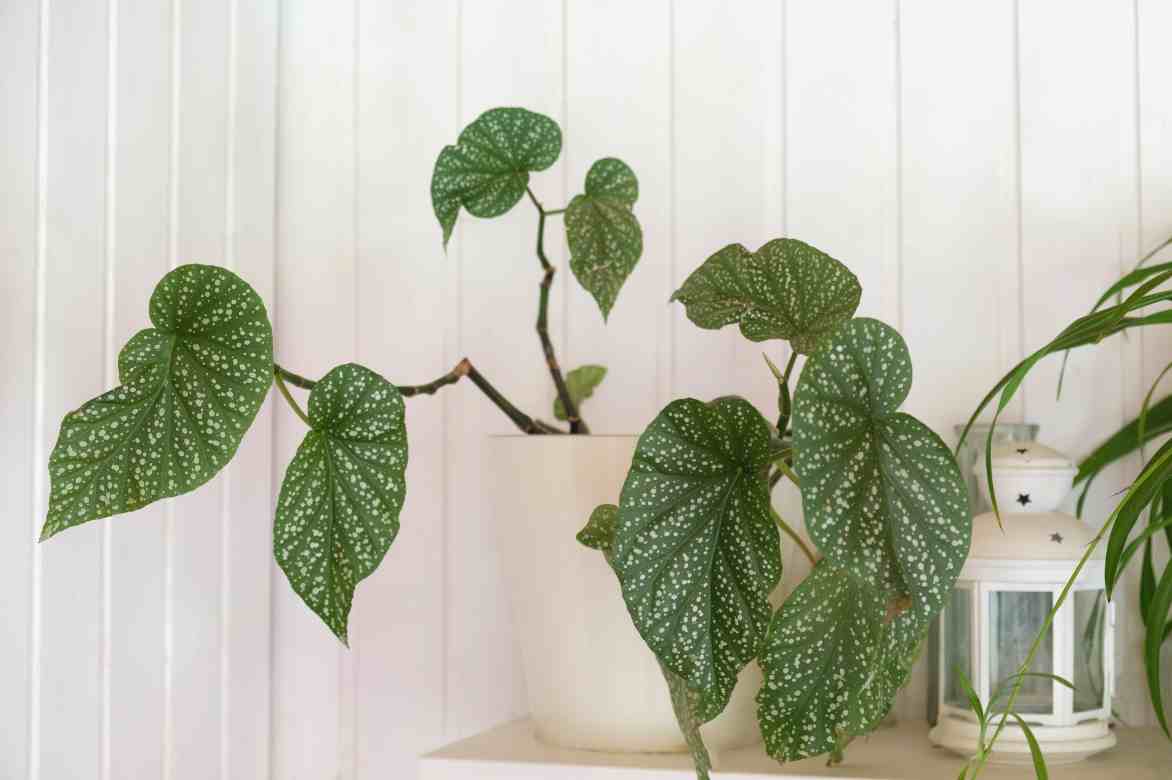
Begonia maculata
Flowering Begonias: Delicacy and Romance
Flowering begonias, such as Begonia eliator or Begonia semperflorens, bring a soft and warm atmosphere thanks to their abundant and colourful blooms.
- In which interior?
- Classic or romantic style: The elegant flowers of the begonia ‘Pink Pop’ find their place in living rooms or bedrooms decorated with soft textiles, weathered wood furniture, and pastel tones.
- Cottage or chic country style: The Begonia semperflorens, with their delicate and persistent small flowers, are perfect for adding a bucolic touch to a kitchen or dining area.
- Warm contemporary style: Placed in bright spaces with neutral tones and a few colourful accents, flowering begonias like the Begonia amphioxus create a soothing focal point.
- In which type of pot?
- Pastel ceramic or frosted glass pots: These containers enhance the softness and romance of pink, white, or red flowers. For example, a pale pink Begonia eliator will look stunning in a powder pink ceramic pot.
- Elegant hanging planters: Trailing or slender-stemmed flowering begonias, such as certain hybrids, adapt perfectly to macramé or gold metal hangers for an airy decoration.
- Wicker or rattan cache-pots: Ideal for a rustic or bohemian interior. The Begonia semperflorens, for example, find a natural setting that enhances their delicate blooms.
Tips for Incorporating Begonias into Decor
- Group staging: Combine several begonias of different varieties in matching or complementary pots to create a dynamic composition.
- Standalone centrepiece: Place a standout foliage begonia like the Begonia rex ‘Escargot’ or a flowering begonia like the Begonia eliator on a console or coffee table in an elegant pot that draws the eye.
- In a bright corner: Position a Begonia maculata on a stand or shelf near a window to capture indirect light and play with its speckled reflections.
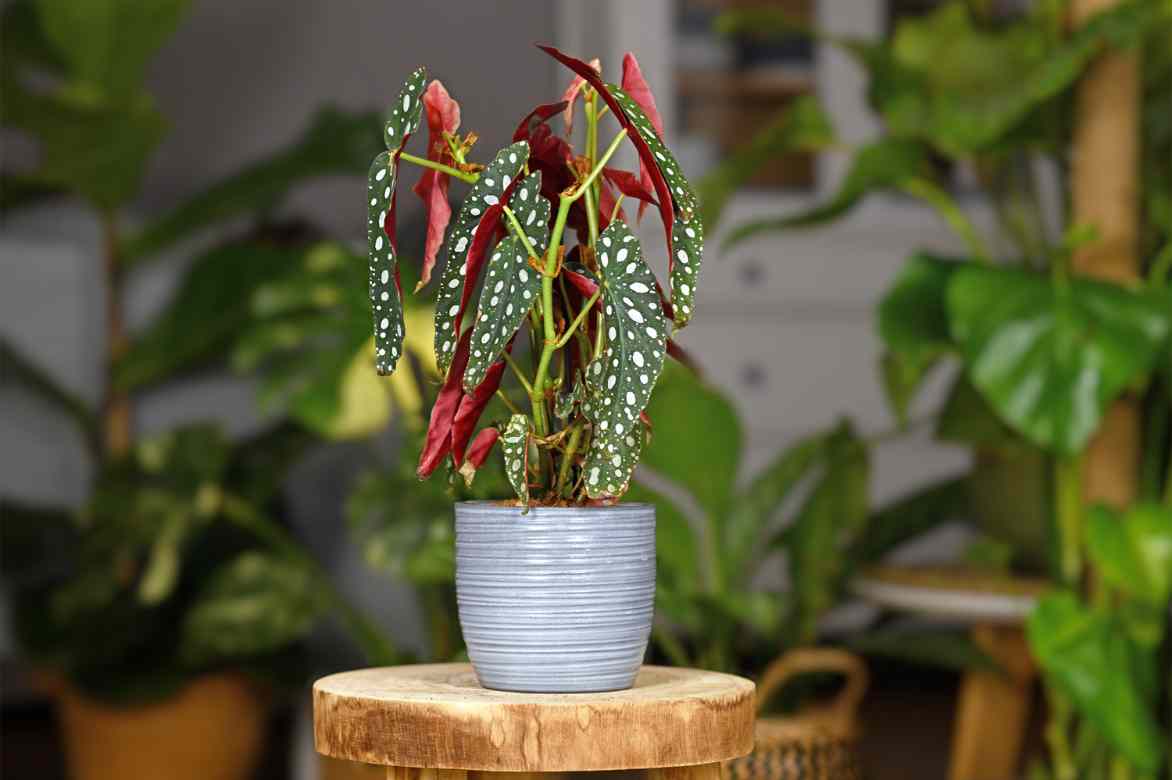
Begonia maculata
See also
→To care for your plant, discover our article: Diseases and Pests of Indoor Begonias.
→Explore our wide range of indoor plants.
→Our decorative foliage indoor plants and our flowering indoor plants.
→There are many books on indoor plants, but we recommend THE bible on the subject: The Encyclopedia of Indoor Plants by Solène Moutardier, published by Ulmer.
- Subscribe!
- Contents
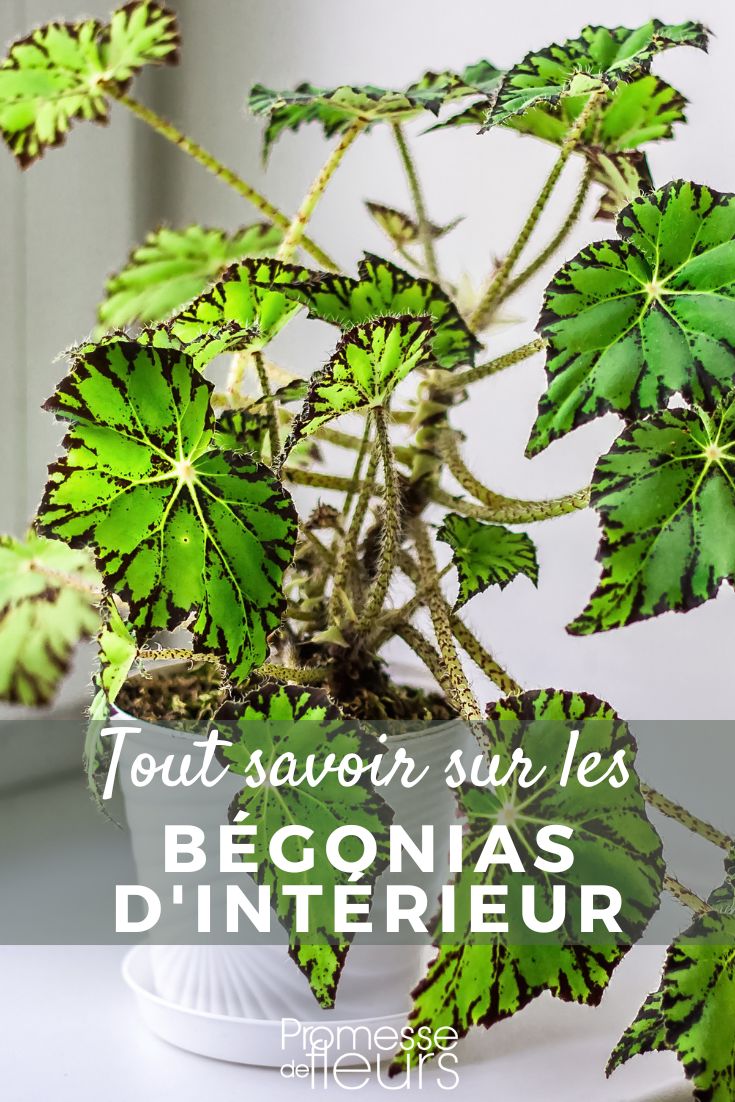


































Comments